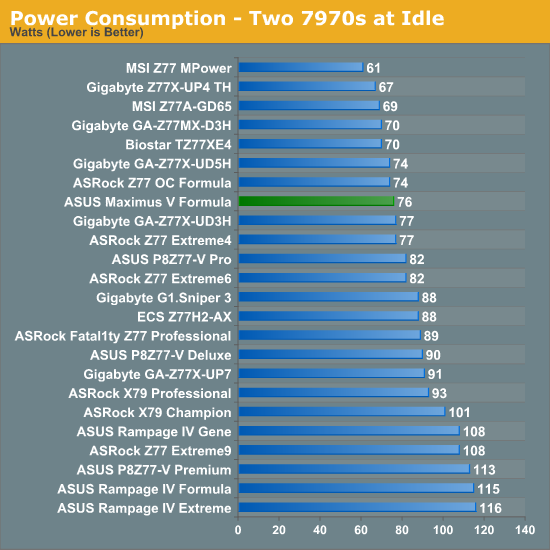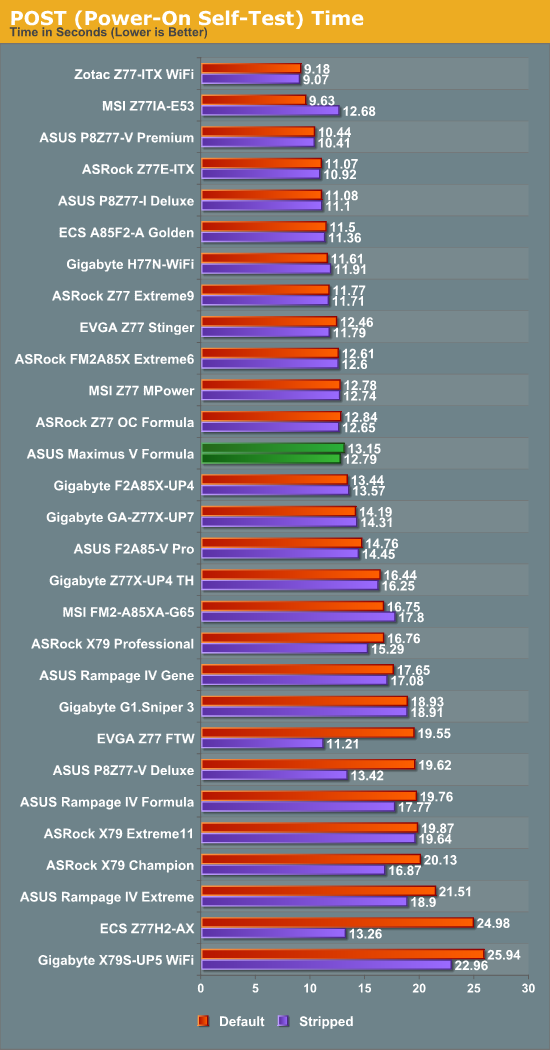ASUS Maximus V Formula Z77 ROG Review
by Ian Cutress on March 25, 2013 2:30 PM EST- Posted in
- Motherboards
- Asus
- ROG
- Z77
Many thanks to...
We must thank the following companies for kindly providing hardware for our test bed:
Thank you to OCZ for providing us with the 1250W Gold Power Supply and USB testing SSD.
Thank you to G.Skill for providing us with the memory kits.
Thank you to ASUS for providing us with the AMD GPUs and some IO Testing kit.
Thank you to ECS for providing us with the NVIDIA GPUs.
Test Setup
Power Consumption
Power consumption was tested on the system as a whole with a wall meter connected to the OCZ 1250W power supply, while in a dual 7970 GPU configuration. This power supply is Gold rated, and as I am in the UK on a 230-240 V supply, leads to ~75% efficiency > 50W, and 90%+ efficiency at 250W, which is suitable for both idle and multi-GPU loading. This method of power reading allows us to compare the power management of the UEFI and the board to supply components with power under load, and includes typical PSU losses due to efficiency. These are the real world values that consumers may expect from a typical system (minus the monitor) using this motherboard.
While this method for power measurement may not be ideal, and you feel these numbers are not representative due to the high wattage power supply being used (we use the same PSU to remain consistent over a series of reviews, and the fact that some boards on our test bed get tested with three or four high powered GPUs), the important point to take away is the relationship between the numbers. These boards are all under the same conditions, and thus the differences between them should be easy to spot.

Out of the OC motherboards we have tested, the MSI Z77 MPower and ASRock Z77 OC Formula have been very efficient compared to almost every other board tested. The Gigabyte Z77X-UP7 came fairly low down in our power tests due to the number of power phases as well as the PLX chip onboard. The ASUS MVF follows the MSI and ASRock and stays in the top half for power consumption.
POST Time
Different motherboards have different POST sequences before an operating system is initialized. A lot of this is dependent on the board itself, and POST boot time is determined by the controllers on board (and the sequence of how those extras are organized). As part of our testing, we are now going to look at the POST Boot Time - this is the time from pressing the ON button on the computer to when Windows starts loading. (We discount Windows loading as it is highly variable given Windows specific features.) These results are subject to human error, so please allow +/- 1 second in these results.

Out of the Z77 OC boards we have tested, MSI, ASRock and ASUS all hover around the 13 second mark for Windows 7 POST with dual 7970s and the Gigabyte UP7 is a second behind.










38 Comments
View All Comments
UzairH - Tuesday, March 26, 2013 - link
When I researched the effects of x8 vs x16, some games did have tangible framerates hits. I also understand there is some latency from the PLX chip, so the question is: does the MVF utilize the PLX when two graphics cards are deployed, or only when 3 are in use?IanCutress - Tuesday, March 26, 2013 - link
The PLX chip on the MVF works with IO as it is a PCIe 2.0 switch. It is not the PLX8747 commonly used to dissect PCIe 3.0 lanes for GPUs.UzairH - Tuesday, March 26, 2013 - link
Thanks for clearing that up Ian :) I take it then that there is NO latency from the PLX chip since it doesn't do anything with the PCIe slots.Overall, I am trying to decide between this board or the ASRock Z77 OC Formula. Ian, which of these two would you use yourself in a gaming build with GTX 670 SLI and a standard overclocked (4.2~4.4 GHz) 3570k? One important value-add is of course the "SupremeFX IV" audio solution on the MVF - I was considering getting one of Asus' Xonar cards for sound, how would you say the SupremeFX IV compares to the DX or Essence STX when paired with good headphones?
hurrakan - Tuesday, March 26, 2013 - link
I wish they would stop using the Intel 82579V NIC, or at least fix it - it's been horrendously broken for years. Search Google for "82579v" and you'll see.It constantly disconnects every minute unless you force it to 100Mbps. I wish I had bought a motherboard with dual LAN. And I'm going to make sure my next motherboard does not have Intel 82579V!
vailr - Tuesday, March 26, 2013 - link
The Intel 82579V NIC has performed fawlessly on my Gigabyte Z77-UD5H board.Maybe your board's NIC has a defect?
hurrakan - Sunday, April 14, 2013 - link
It was fine for a few months, then started disconnecting and reconnecting every 2 minutes - extremely annoying and made playing MMOs impossible. Now it only works by forcing to 100MBps instead of 1GBps.Apparently a very common problem - there's a 13 page thread on Intel community forums.
I saw one place suggest it is caused by the Gigabit Ethernet region of the motherboard BIOS getting corrupted.
Sabresiberian - Tuesday, April 2, 2013 - link
I would rather they add a PLX chip than spend the money on beefing up the audio capabilities of the mainboard. I mean, they did a good job as far as they went, but its still not as good as, say, one of their own Xonar solutions, which is what I'm going to use anyway. To me, either you care about better sound and you are going to spend a little money to get it, or you're happy with what comes on mainboards and so aren't; an in-between solution is a solution for a kind of person that I don't think really exists.Nivin - Thursday, May 2, 2013 - link
Just wondering. Does this motherboard come with a liquid cooling system of its own or is it just optimized for one. I am planning to buy this for my gaming pc but i also am going to buy a Cooler Master Seidon 240m if the motherboard doesnt have its own liquid cooling system. Also, if it does come with a LCS, is it good compared to getting one yourself.Thanks, Nivin